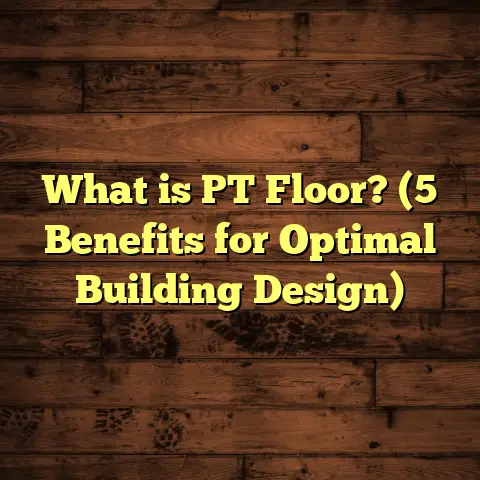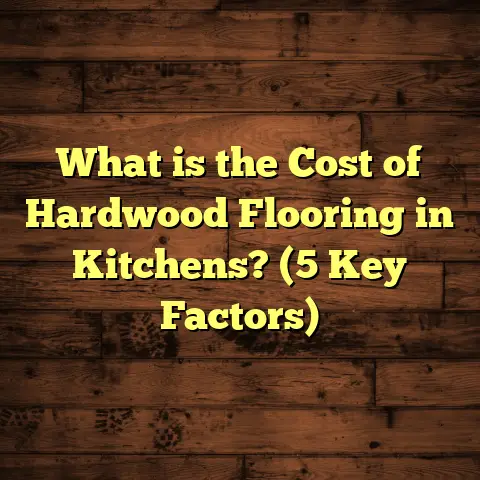What is Parawood Flooring? (5 Key Benefits You Must Know)
Life moves fast. Between juggling work deadlines, family responsibilities, and trying to carve out some “me time,” floors aren’t usually top of mind. But believe me, when you stop to think about it, your floor plays a huge role in how your home feels and functions every single day. It’s the foundation you walk on, the backdrop for your furniture, and the surface that takes all kinds of wear and tear. I’ve spent years working with different flooring materials, and one option that’s really caught my eye lately is parawood flooring. It’s not as common as oak or maple but has some unique benefits that make it worth a serious look. Let me walk you through everything I know about parawood flooring—what it is, why it matters, and why you might want to consider it for your next project.
What Is Parawood Flooring?
Alright, let’s start with the basics. Parawood flooring comes from the rubber tree, scientifically known as Hevea brasiliensis. You probably know rubber trees because of latex—the milky substance harvested to make natural rubber products like tires, gloves, and balloons. After about 25 to 30 years of producing latex, these trees are typically cut down because their latex yield declines. Instead of wasting that wood, it’s harvested and processed into lumber used for furniture, toys, and yes—flooring.
Why is this interesting? Well, most of the time when trees are cut down for timber, it means deforestation or logging in natural forests. Parawood is different because it uses timber from rubber plantations that have reached the end of their latex-producing life cycle. So it’s a form of recycling or repurposing that helps reduce waste and pressure on natural forests.
The wood is dense with a tight grain, giving it a smooth surface that takes finishes well. It looks similar to traditional hardwoods like maple or oak but tends to be lighter in color with a subtle warmth to its tone.
The process of turning rubberwood into flooring involves drying the wood carefully to eliminate moisture and then treating it against fungi and insects. The planks are then sanded and coated with durable finishes like polyurethane or oil-based sealants to protect against scratches and moisture.
What I find cool about parawood is this blend of sustainability and practicality—it’s a material born from necessity but ends up being a stylish choice for homes and businesses alike.
1. Sustainability That Feels Right
I’m passionate about eco-friendly building materials because I want my work to leave a positive mark on the planet. Parawood flooring fits perfectly into that mindset.
Since rubber trees are grown primarily for latex production, once their productive life ends, using the wood avoids waste. Otherwise, these trees might be burned or discarded—wasting resources and adding to environmental pollution.
To give you some perspective: Rubberwood plantations cover millions of acres in Southeast Asia. Thailand alone produces around 3 million cubic meters of rubberwood annually. Without repurposing this wood, much of it would go unused.
This sustainable edge resonated with me personally when I first learned about parawood. I had just finished a project where the client wanted wood floors but was concerned about sourcing materials responsibly. Parawood was the perfect answer because it supported existing agricultural industries without encouraging deforestation.
Plus, rubberwood plantations are managed commercially, which means the wood supply chain is reliable and less prone to illegal logging practices often seen in tropical hardwood harvesting.
2. Strong Enough for Daily Life
One thing people worry about when choosing flooring is durability. Can it handle kids running around? Pets scratching? Furniture moving? From what I’ve seen, parawood holds up really well.
Let’s talk numbers for a moment. The Janka hardness test measures how resistant wood is to dents and wear by pressing a steel ball into the surface. Parawood scores around 960 pounds-force (lbf). For comparison:
- Red Oak: 1290 lbf
- Hard Maple: 1450 lbf
- Pine (a softer wood): 420 lbf
While parawood isn’t the hardest wood out there, it’s significantly tougher than softwoods like pine or fir and performs well enough for most residential settings.
I remember working on a family home where they had two energetic kids and a dog that loved to play indoors. They wanted floors tough enough to withstand roughhousing but still warm and inviting. We picked parawood flooring with a high-quality finish that resisted scratches and dents surprisingly well over the first year.
What helps parawood’s durability is its density—it’s heavier than many other woods used in flooring—which makes it less prone to warping or cupping when exposed to humidity changes.
3. A Budget-Friendly Option That Looks Great
Good wood floors often come with a hefty price tag, which can make homeowners hesitate. Parawood offers an affordable alternative without feeling cheap.
Because rubber trees grow relatively fast (about 25-30 years), compared to hardwoods like oak that can take decades or even centuries to mature, the cost of raw material is lower.
From my experience sourcing materials for projects across different budgets, parawood flooring usually costs between $3 to $6 per square foot installed. Contrast that with hardwoods like red oak or maple which often run $5 to $12 per square foot.
That difference can add up quickly in large rooms or whole-house installations.
What’s impressive is that despite being budget-friendly, parawood still delivers on aesthetics. The fine grain and light tone provide a clean look that can be customized with stains or left natural for a Scandinavian vibe.
For example, I installed parawood flooring in a newly opened cafe where the owner wanted natural wood but had strict budget limits. We stained the floors a warm walnut color which gave the space an inviting feel without overshooting costs.
4. Simple Maintenance for Everyday Living
If you’re like me—or many of my clients—you want floors that don’t require a lot of fuss every day. Parawood ticks that box nicely.
Its tight grain means dirt doesn’t get trapped easily. Cleaning is straightforward: regular sweeping or vacuuming keeps dust at bay, and spills wipe up with a damp cloth effortlessly.
One of my favorite things about parawood is how well it holds finishes. Whether you choose a polyurethane coating or natural oils like tung or linseed oil, the surface resists stains and scratches better than many other woods.
I always advise clients to avoid harsh chemical cleaners or excessive water when mopping—just mild soap solutions work best.
Every few years, refinishing the floor restores its shine and protects the wood underneath. And because parawood sands well thanks to its uniform texture, refinishing is usually quick and effective.
In one project with elderly homeowners who wanted low-maintenance solutions but beautiful floors, parawood was perfect—they could keep their floors looking fresh with minimal effort.
5. Design Versatility That Lets You Be You
Maybe you’re someone who loves rustic charm, or perhaps you prefer modern minimalism? Either way, parawood adapts well to many design styles.
The natural pale color lends itself to lighter stains—think honey or golden oak—for bright airy rooms. Alternatively, darker stains like walnut or espresso add richness and warmth suited for cozy living spaces or offices.
I’ve experimented with different finishes on parawood floors—from matte oils for a natural feel to glossy polyurethanes for more formal settings—and each creates a different vibe without losing durability.
Parawood can also be installed as solid planks or engineered flooring (layers of wood glued together) which expands where you can use it:
- Nail-down installation works well on wooden subfloors.
- Glue-down is ideal for concrete slabs.
- Floating floors (click-lock systems) are popular in DIY projects or rentals since they’re easy to install and remove.
This flexibility means you can find parawood flooring options whether renovating an old home or building new construction.
A Deeper Look: Data and Practical Insights
Let’s get into some more numbers and real-world examples that will help you picture how parawood performs compared to other woods.
| Wood Type | Janka Hardness (lbf) | Average Cost per Sq Ft Installed | Moisture Resistance | Environmental Impact | Average Lifespan (Years) |
|---|---|---|---|---|---|
| Parawood | 960 | $3 – $6 | Moderate | Low (repurposed) | 20-30 |
| Red Oak | 1290 | $5 – $10 | Moderate | Moderate | 30-50 |
| Maple | 1450 | $6 – $12 | Low | Moderate | 30-50 |
| Bamboo | 1380 | $4 – $8 | High | Low (fast-growing) | 20-30 |
| Pine | 420 | $2 – $5 | Low | Moderate | 10-20 |
Moisture resistance refers to how well the wood handles humidity changes without swelling or warping. Parawood has moderate tolerance but should still be sealed properly in damp environments.
Environmental impact rates how sustainable the wood source is—parawood scores highly because it reuses plantation timber instead of cutting virgin forests.
Case Study: Coastal Home Flooring
In Florida, I worked on a beach house renovation where moisture and salt air posed real challenges for flooring choices. The homeowners wanted wood floors but had experienced issues with warping on previous hardwood installations.
We decided on engineered parawood flooring with a waterproof finish layer. After two years:
- Floors showed minimal swelling or distortion.
- The finish remained intact despite sandy foot traffic.
- Maintenance was simple—just regular sweeping and occasional mopping.
This case proved parawood’s suitability for humid climates when finished correctly.
Case Study: Urban Apartment Makeover
A young couple in New York sought affordable yet stylish floors for their compact apartment. They valued eco-conscious materials but needed something durable enough for heavy foot traffic during parties or gatherings.
We installed floating engineered parawood planks stained in a medium walnut shade. Feedback after six months:
- Floors resisted scratches from high heels.
- The warm tone brightened up their small space.
- Installation was quick with minimal mess—a big plus in city renovations.
My Personal Journey with Parawood Flooring
Throughout my career as a flooring contractor, I’ve seen trends come and go—hardwood was king for decades; laminate grew popular for budget reasons; now vinyl planks dominate many markets due to water resistance and ease of installation.
Parawood feels like one of those hidden gems that more people should know about. When I started using it about five years ago after discovering its sustainable story and testing its durability firsthand, it quickly became one of my favorites for certain projects.
One project stands out vividly: I helped renovate an old farmhouse where the client wanted natural wood floors but had concerns about environmental impact and budget constraints. We chose solid parawood planks finished with natural oil. The client loved how the floor looked aged yet refined after installation—perfectly matching their rustic décor theme.
What I enjoyed most was watching how easily the floor held up during family gatherings—kids playing board games on the floor, pets lounging by the fireplace—and cleaned up beautifully afterward.
Common Questions About Parawood Flooring
Is parawood suitable for kitchens and bathrooms?
Generally, wood floors aren’t recommended in areas prone to standing water like bathrooms unless properly sealed and maintained. Parawood can work in kitchens if spills are promptly cleaned and moisture levels controlled.
How does parawood compare to bamboo?
Both are eco-friendly options; bamboo grows faster but has different grain aesthetics and hardness levels. Bamboo tends to be harder (Janka ~1380) but sometimes less stable in humid conditions than parawood engineered flooring.
Can I refinish parawood multiple times?
Yes! Solid parawood floors can be sanded and refinished multiple times depending on plank thickness—typically every 5-7 years under normal wear conditions.
Is parawood resistant to termites or insects?
Rubberwood is naturally susceptible to insects if untreated. That’s why kiln drying and chemical treatments during manufacturing are essential steps before installation.
Final Thoughts (Without Saying “In Conclusion”)
Thinking back over all the homes and businesses where I’ve installed parawood floors, what strikes me most is how well this material balances practical needs with thoughtful sustainability. It’s not just another wood option—it’s an intelligent choice for people who want beauty without compromise on ethics or budget.
If you’re considering new floors soon, I suggest giving parawood a serious look alongside other hardwoods or engineered options. It’s versatile enough for many spaces—from cozy living rooms to bustling commercial areas—and offers peace of mind knowing you’re using reclaimed plantation timber wisely.
And if you want help deciding whether parawood fits your home’s needs—or need tips on installation and care—I’m just a message away!





